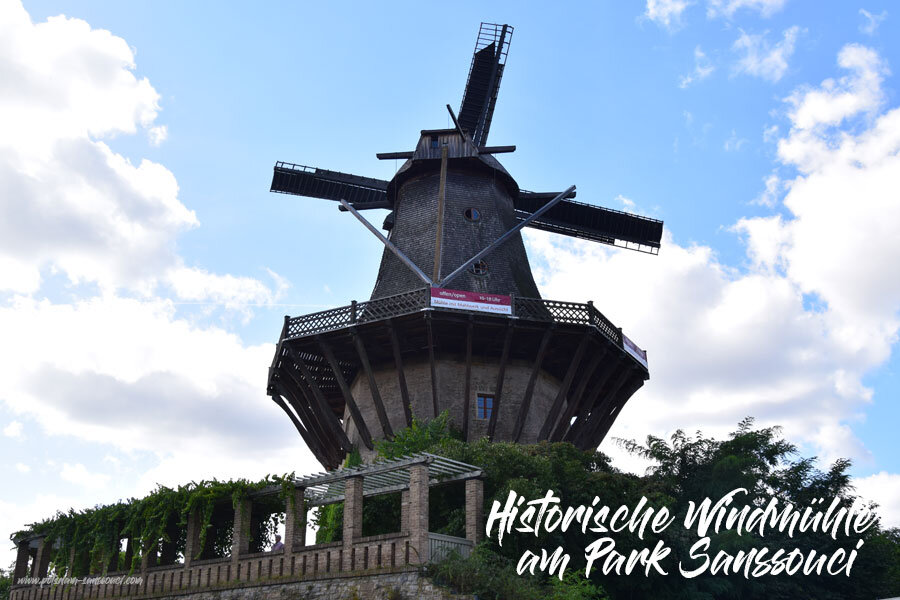
The Historic Windmill at Sanssouci Park
The Historic Windmill at Sanssouci Palace, known for the legend of Frederick the Great and the miller Grävenitz, was reconstructed after World War II. Today, the Berlin-Brandenburg Mill Association operates the mill as a museum, featuring an exhibition on milling history and grain processing. Visitors can purchase Sanssouci flour and enjoy views of the palace grounds. The mill symbolizes Frederick II’s sense of justice and is a significant testament to Potsdam’s milling tradition.
Table of contents
The Historic Windmill of Sanssouci: Legend and Tradition
The windmill at Sanssouci Palace, one of Germany’s most famous mills, is renowned for the legend of Frederick the Great and the miller Grävenitz. The king reportedly found the mill’s noise disruptive and demanded its removal. The miller countered by appealing to the chamber court, after which the king withdrew his demand.
The original post mill, built in 1738, became dilapidated and was replaced by a Dutch windmill that was destroyed during World War II. Since 1993, the reconstructed Historic Windmill of Sanssouci has been operational again. Operated by the Berlin-Brandenburg Mill Association, the mill hosts an exhibition on the history of milling and grain processing. Visitors can purchase Sanssouci flour at the museum shop.
The mill is a reproduction of the gallery Dutch windmill built between 1787 and 1791 and is located west of Sanssouci Palace. The wooden structure destroyed during the war was reconstructed between 1991 and 1993. The mill continues to produce organic flour and serves as a museum, vividly illustrating the mill’s operation and history.
Visitors can purchase Sanssouci flour on the ground floor of the mill and explore the permanent exhibition showcasing the arduous process of grinding. The mill offers a magnificent view of the Sanssouci palace grounds and is an important example of Potsdam’s milling tradition. The legend of Frederick II and the mill has been featured in literature, plays, and films.
History of the Historic Windmill at Sanssouci Park
In the early 18th century, during the reign of Frederick William I, Potsdam became a significant garrison and residence city, increasing the demand for mills. In 1736, miller Johann Wilhelm Ludewig Grävenitz received permission to build a post mill on the Bornstedt ridge, which was completed by 1739. Due to disputes over lease payments and disruptions caused by the construction of Sanssouci Palace, conflicts arose with the Military Orphanage Foundation and King Frederick II. In 1749, Grävenitz was permitted to build another mill, which later burned down, prompting him to construct a new mill and eventually sell the post mill.
Frederick II viewed the mills in the landscape around Sanssouci Palace as decorative elements and approved the construction of additional mills. Despite numerous complaints about insufficient wind, the mills remained part of the landscape. The post mill was operated by various millers until Frederick William II had it demolished in 1786 to build a new Dutch-style gallery windmill. This mill, with construction costs totaling 24,344 thalers, began operating in 1791 and continued, despite frequent complaints and ownership changes, until Frederick II’s death. After several ownership changes, the mill ceased operations in 1858 and became a listed museum.
After World War II and the destruction of the mill and the Swiss house, restoration of the mill base began in 1983. With financial support, reconstruction was completed in 1993. The present gallery windmill, a replica of the original, has operated as a museum since 1995. It houses a permanent exhibition on mills in Brandenburg and Berlin and allows visitors to view the surroundings from a 10.85-meter-high observation platform.

Architecture, Construction, and Operation of the Historic Mill
The mill represents Dutch architecture from around 1800. It has a wooden construction with an octagonal frame, a rotating cap, and sails mounted on a brick base with a gallery. The total height of the building is 25.78 meters, including the sails 35.45 meters. The boat-shaped cap sits on an iron ring and houses the 5.5-meter-long sail shaft with a cross of four 12-meter-long sails. The cap and sails are turned into the wind using a winch, with the sails achieving a working speed of 15 rpm and a circumferential speed of 67.8 km/h. A brake pole stops the sail cross.
Inside the mill, machines sourced from other mills or newly manufactured operate. The single-pass gravity mill functions like a small 19th-century grain mill. Grain is lifted via a winch to the gallery and millstones on the fifth floor, where it is ground at 120 rpm. The flour collects in a casing, or vat, and is transported to an “Ascania” model sieve on the fourth floor, where it is screened and sorted by size. Flour is conveyed to bags via a flour collection screw, while coarser materials are reground. A standing mixer combines the flours before bagging. Equipment also includes a grain crusher and a grits cutter.
Address
Maulbeerallee 5, 14469 Potsdam
Images
Frequently Asked Questions
What is the cost of visiting Sanssouci Park and Sanssouci Palace?
Sanssouci Park is free of charge, though a voluntary contribution to park maintenance is appreciated. You can enjoy guided tours and activities by choosing one of our partners' top offers. The best option for visiting Sanssouci Palace is the "Sanssouci+ Ticket" (including Sanssouci Palace), which grants one-time access to all* open palaces of the Prussian Palaces and Gardens Foundation Berlin-Brandenburg in Potsdam.
How many days should you plan for a visit to Potsdam?
Take your time to explore Potsdam. Plan a multi-day trip to experience the city at a relaxed pace. We have carefully selected the best hotels in Potsdam for your stay. Enjoy your visit!
Which sights should you not miss when visiting Potsdam?
Where can I park near Sanssouci Park?
For a safe arrival by car in Potsdam, we have compiled key information on the best parking lots and parking options around Sanssouci Palace and Sanssouci Park. Enjoy your time in Potsdam worry-free!
